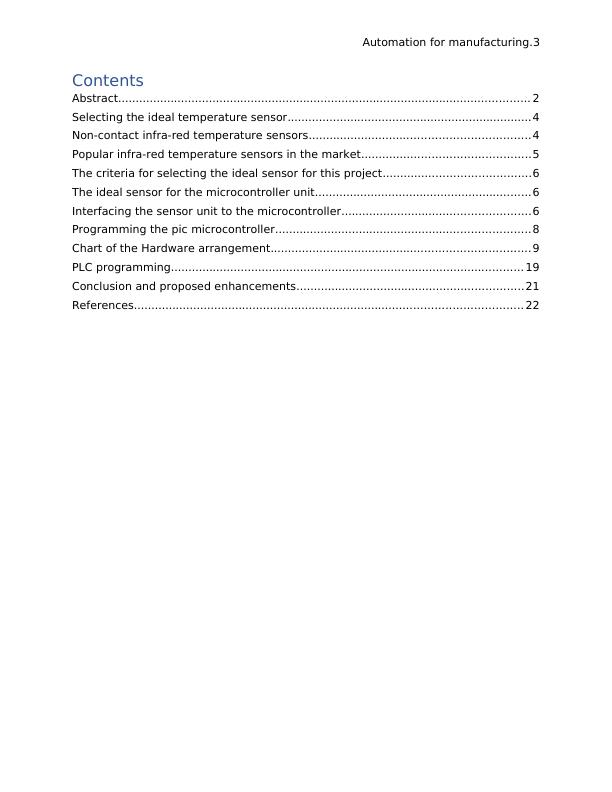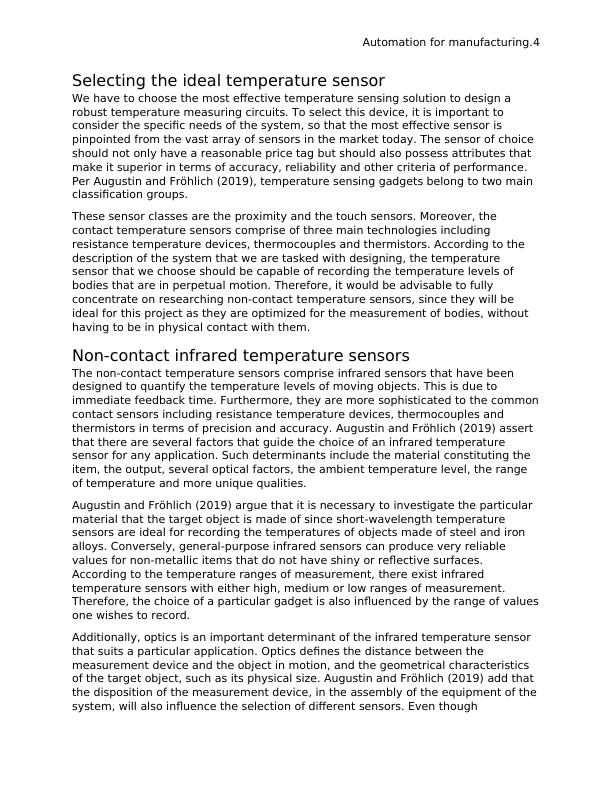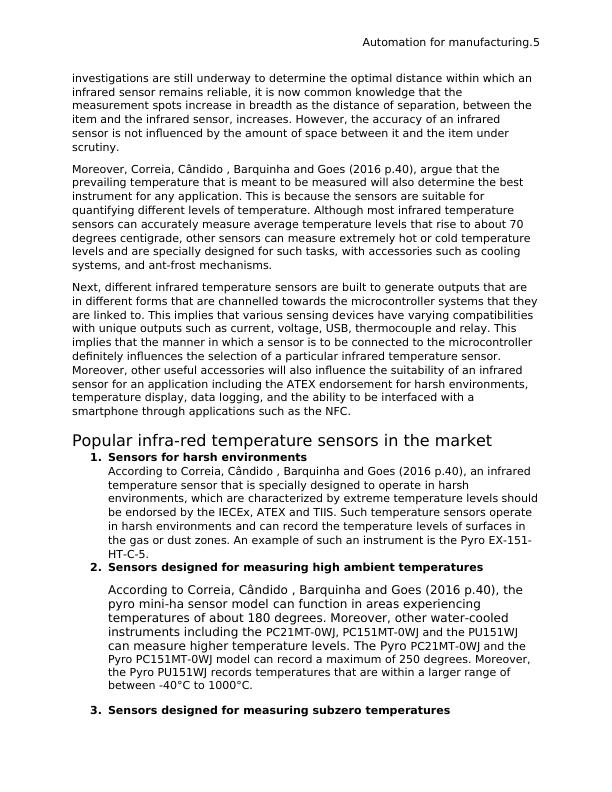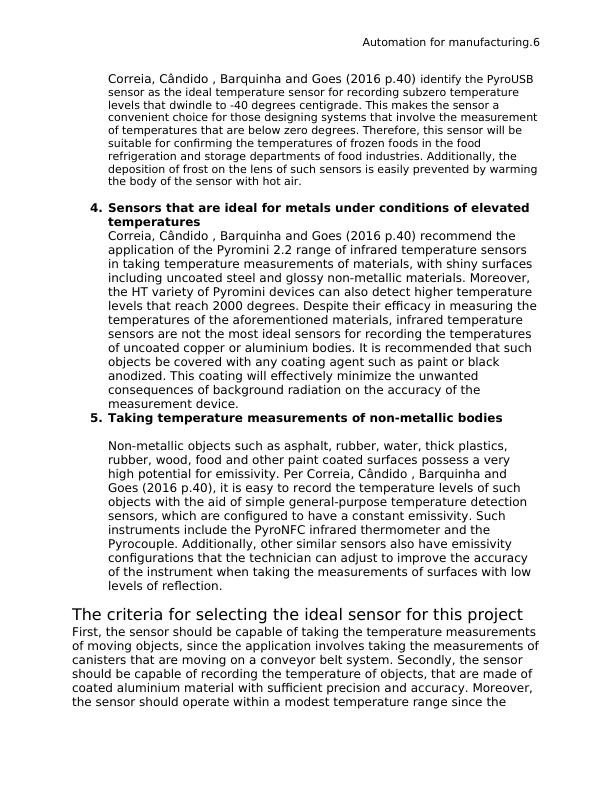Automation for Manufacturing: Non-Contact Temperature Sensors and PIC Microcontroller Programming
Added on 2022-11-16
24 Pages5927 Words387 Views
Automation for manufacturing.1
AUTOMATION FOR MANUFACTURING
by (Name)
The Name of the Class (Course)
Professor (Tutor)
The Name of the School (University)
AUTOMATION FOR MANUFACTURING
by (Name)
The Name of the Class (Course)
Professor (Tutor)
The Name of the School (University)

Automation for manufacturing.2
Abstract
This project involves the control of a conveyor belt system, which transports food
canisters to a refrigeration chamber, with the PIC18f2455 sensor and a PLC system.
First, a general analysis of temperature analysis is conducted and the major contact
temperature sensors including the resistance temperature devices, thermocouples
and thermistors are ruled out as viable temperature sensing solutions for this
project. Next, a detailed analysis of the most effective infrared sensors is done to
single out the best non-contact sensor for this application. Moreover, steps taken to
program the microcontroller will be comprehensively explained, and a program for
the PLC section of the project will be proposed.
Abstract
This project involves the control of a conveyor belt system, which transports food
canisters to a refrigeration chamber, with the PIC18f2455 sensor and a PLC system.
First, a general analysis of temperature analysis is conducted and the major contact
temperature sensors including the resistance temperature devices, thermocouples
and thermistors are ruled out as viable temperature sensing solutions for this
project. Next, a detailed analysis of the most effective infrared sensors is done to
single out the best non-contact sensor for this application. Moreover, steps taken to
program the microcontroller will be comprehensively explained, and a program for
the PLC section of the project will be proposed.

Automation for manufacturing.3
Contents
Abstract...................................................................................................................... 2
Selecting the ideal temperature sensor......................................................................4
Non-contact infra-red temperature sensors...............................................................4
Popular infra-red temperature sensors in the market................................................5
The criteria for selecting the ideal sensor for this project..........................................6
The ideal sensor for the microcontroller unit..............................................................6
Interfacing the sensor unit to the microcontroller......................................................6
Programming the pic microcontroller.........................................................................8
Chart of the Hardware arrangement..........................................................................9
PLC programming..................................................................................................... 19
Conclusion and proposed enhancements.................................................................21
References............................................................................................................... 22
Contents
Abstract...................................................................................................................... 2
Selecting the ideal temperature sensor......................................................................4
Non-contact infra-red temperature sensors...............................................................4
Popular infra-red temperature sensors in the market................................................5
The criteria for selecting the ideal sensor for this project..........................................6
The ideal sensor for the microcontroller unit..............................................................6
Interfacing the sensor unit to the microcontroller......................................................6
Programming the pic microcontroller.........................................................................8
Chart of the Hardware arrangement..........................................................................9
PLC programming..................................................................................................... 19
Conclusion and proposed enhancements.................................................................21
References............................................................................................................... 22

Automation for manufacturing.4
Selecting the ideal temperature sensor
We have to choose the most effective temperature sensing solution to design a
robust temperature measuring circuits. To select this device, it is important to
consider the specific needs of the system, so that the most effective sensor is
pinpointed from the vast array of sensors in the market today. The sensor of choice
should not only have a reasonable price tag but should also possess attributes that
make it superior in terms of accuracy, reliability and other criteria of performance.
Per Augustin and Fröhlich (2019), temperature sensing gadgets belong to two main
classification groups.
These sensor classes are the proximity and the touch sensors. Moreover, the
contact temperature sensors comprise of three main technologies including
resistance temperature devices, thermocouples and thermistors. According to the
description of the system that we are tasked with designing, the temperature
sensor that we choose should be capable of recording the temperature levels of
bodies that are in perpetual motion. Therefore, it would be advisable to fully
concentrate on researching non-contact temperature sensors, since they will be
ideal for this project as they are optimized for the measurement of bodies, without
having to be in physical contact with them.
Non-contact infrared temperature sensors
The non-contact temperature sensors comprise infrared sensors that have been
designed to quantify the temperature levels of moving objects. This is due to
immediate feedback time. Furthermore, they are more sophisticated to the common
contact sensors including resistance temperature devices, thermocouples and
thermistors in terms of precision and accuracy. Augustin and Fröhlich (2019) assert
that there are several factors that guide the choice of an infrared temperature
sensor for any application. Such determinants include the material constituting the
item, the output, several optical factors, the ambient temperature level, the range
of temperature and more unique qualities.
Augustin and Fröhlich (2019) argue that it is necessary to investigate the particular
material that the target object is made of since short-wavelength temperature
sensors are ideal for recording the temperatures of objects made of steel and iron
alloys. Conversely, general-purpose infrared sensors can produce very reliable
values for non-metallic items that do not have shiny or reflective surfaces.
According to the temperature ranges of measurement, there exist infrared
temperature sensors with either high, medium or low ranges of measurement.
Therefore, the choice of a particular gadget is also influenced by the range of values
one wishes to record.
Additionally, optics is an important determinant of the infrared temperature sensor
that suits a particular application. Optics defines the distance between the
measurement device and the object in motion, and the geometrical characteristics
of the target object, such as its physical size. Augustin and Fröhlich (2019) add that
the disposition of the measurement device, in the assembly of the equipment of the
system, will also influence the selection of different sensors. Even though
Selecting the ideal temperature sensor
We have to choose the most effective temperature sensing solution to design a
robust temperature measuring circuits. To select this device, it is important to
consider the specific needs of the system, so that the most effective sensor is
pinpointed from the vast array of sensors in the market today. The sensor of choice
should not only have a reasonable price tag but should also possess attributes that
make it superior in terms of accuracy, reliability and other criteria of performance.
Per Augustin and Fröhlich (2019), temperature sensing gadgets belong to two main
classification groups.
These sensor classes are the proximity and the touch sensors. Moreover, the
contact temperature sensors comprise of three main technologies including
resistance temperature devices, thermocouples and thermistors. According to the
description of the system that we are tasked with designing, the temperature
sensor that we choose should be capable of recording the temperature levels of
bodies that are in perpetual motion. Therefore, it would be advisable to fully
concentrate on researching non-contact temperature sensors, since they will be
ideal for this project as they are optimized for the measurement of bodies, without
having to be in physical contact with them.
Non-contact infrared temperature sensors
The non-contact temperature sensors comprise infrared sensors that have been
designed to quantify the temperature levels of moving objects. This is due to
immediate feedback time. Furthermore, they are more sophisticated to the common
contact sensors including resistance temperature devices, thermocouples and
thermistors in terms of precision and accuracy. Augustin and Fröhlich (2019) assert
that there are several factors that guide the choice of an infrared temperature
sensor for any application. Such determinants include the material constituting the
item, the output, several optical factors, the ambient temperature level, the range
of temperature and more unique qualities.
Augustin and Fröhlich (2019) argue that it is necessary to investigate the particular
material that the target object is made of since short-wavelength temperature
sensors are ideal for recording the temperatures of objects made of steel and iron
alloys. Conversely, general-purpose infrared sensors can produce very reliable
values for non-metallic items that do not have shiny or reflective surfaces.
According to the temperature ranges of measurement, there exist infrared
temperature sensors with either high, medium or low ranges of measurement.
Therefore, the choice of a particular gadget is also influenced by the range of values
one wishes to record.
Additionally, optics is an important determinant of the infrared temperature sensor
that suits a particular application. Optics defines the distance between the
measurement device and the object in motion, and the geometrical characteristics
of the target object, such as its physical size. Augustin and Fröhlich (2019) add that
the disposition of the measurement device, in the assembly of the equipment of the
system, will also influence the selection of different sensors. Even though

Automation for manufacturing.5
investigations are still underway to determine the optimal distance within which an
infrared sensor remains reliable, it is now common knowledge that the
measurement spots increase in breadth as the distance of separation, between the
item and the infrared sensor, increases. However, the accuracy of an infrared
sensor is not influenced by the amount of space between it and the item under
scrutiny.
Moreover, Correia, Cândido , Barquinha and Goes (2016 p.40), argue that the
prevailing temperature that is meant to be measured will also determine the best
instrument for any application. This is because the sensors are suitable for
quantifying different levels of temperature. Although most infrared temperature
sensors can accurately measure average temperature levels that rise to about 70
degrees centigrade, other sensors can measure extremely hot or cold temperature
levels and are specially designed for such tasks, with accessories such as cooling
systems, and ant-frost mechanisms.
Next, different infrared temperature sensors are built to generate outputs that are
in different forms that are channelled towards the microcontroller systems that they
are linked to. This implies that various sensing devices have varying compatibilities
with unique outputs such as current, voltage, USB, thermocouple and relay. This
implies that the manner in which a sensor is to be connected to the microcontroller
definitely influences the selection of a particular infrared temperature sensor.
Moreover, other useful accessories will also influence the suitability of an infrared
sensor for an application including the ATEX endorsement for harsh environments,
temperature display, data logging, and the ability to be interfaced with a
smartphone through applications such as the NFC.
Popular infra-red temperature sensors in the market
1. Sensors for harsh environments
According to Correia, Cândido , Barquinha and Goes (2016 p.40), an infrared
temperature sensor that is specially designed to operate in harsh
environments, which are characterized by extreme temperature levels should
be endorsed by the IECEx, ATEX and TIIS. Such temperature sensors operate
in harsh environments and can record the temperature levels of surfaces in
the gas or dust zones. An example of such an instrument is the Pyro EX-151-
HT-C-5.
2. Sensors designed for measuring high ambient temperatures
According to Correia, Cândido , Barquinha and Goes (2016 p.40), the
pyro mini-ha sensor model can function in areas experiencing
temperatures of about 180 degrees. Moreover, other water-cooled
instruments including the PC21MT-0WJ, PC151MT-0WJ and the PU151WJ
can measure higher temperature levels. The Pyro PC21MT-0WJ and the
Pyro PC151MT-0WJ model can record a maximum of 250 degrees. Moreover,
the Pyro PU151WJ records temperatures that are within a larger range of
between -40°C to 1000°C.
3. Sensors designed for measuring subzero temperatures
investigations are still underway to determine the optimal distance within which an
infrared sensor remains reliable, it is now common knowledge that the
measurement spots increase in breadth as the distance of separation, between the
item and the infrared sensor, increases. However, the accuracy of an infrared
sensor is not influenced by the amount of space between it and the item under
scrutiny.
Moreover, Correia, Cândido , Barquinha and Goes (2016 p.40), argue that the
prevailing temperature that is meant to be measured will also determine the best
instrument for any application. This is because the sensors are suitable for
quantifying different levels of temperature. Although most infrared temperature
sensors can accurately measure average temperature levels that rise to about 70
degrees centigrade, other sensors can measure extremely hot or cold temperature
levels and are specially designed for such tasks, with accessories such as cooling
systems, and ant-frost mechanisms.
Next, different infrared temperature sensors are built to generate outputs that are
in different forms that are channelled towards the microcontroller systems that they
are linked to. This implies that various sensing devices have varying compatibilities
with unique outputs such as current, voltage, USB, thermocouple and relay. This
implies that the manner in which a sensor is to be connected to the microcontroller
definitely influences the selection of a particular infrared temperature sensor.
Moreover, other useful accessories will also influence the suitability of an infrared
sensor for an application including the ATEX endorsement for harsh environments,
temperature display, data logging, and the ability to be interfaced with a
smartphone through applications such as the NFC.
Popular infra-red temperature sensors in the market
1. Sensors for harsh environments
According to Correia, Cândido , Barquinha and Goes (2016 p.40), an infrared
temperature sensor that is specially designed to operate in harsh
environments, which are characterized by extreme temperature levels should
be endorsed by the IECEx, ATEX and TIIS. Such temperature sensors operate
in harsh environments and can record the temperature levels of surfaces in
the gas or dust zones. An example of such an instrument is the Pyro EX-151-
HT-C-5.
2. Sensors designed for measuring high ambient temperatures
According to Correia, Cândido , Barquinha and Goes (2016 p.40), the
pyro mini-ha sensor model can function in areas experiencing
temperatures of about 180 degrees. Moreover, other water-cooled
instruments including the PC21MT-0WJ, PC151MT-0WJ and the PU151WJ
can measure higher temperature levels. The Pyro PC21MT-0WJ and the
Pyro PC151MT-0WJ model can record a maximum of 250 degrees. Moreover,
the Pyro PU151WJ records temperatures that are within a larger range of
between -40°C to 1000°C.
3. Sensors designed for measuring subzero temperatures

Automation for manufacturing.6
Correia, Cândido , Barquinha and Goes (2016 p.40) identify the PyroUSB
sensor as the ideal temperature sensor for recording subzero temperature
levels that dwindle to -40 degrees centigrade. This makes the sensor a
convenient choice for those designing systems that involve the measurement
of temperatures that are below zero degrees. Therefore, this sensor will be
suitable for confirming the temperatures of frozen foods in the food
refrigeration and storage departments of food industries. Additionally, the
deposition of frost on the lens of such sensors is easily prevented by warming
the body of the sensor with hot air.
4. Sensors that are ideal for metals under conditions of elevated
temperatures
Correia, Cândido , Barquinha and Goes (2016 p.40) recommend the
application of the Pyromini 2.2 range of infrared temperature sensors
in taking temperature measurements of materials, with shiny surfaces
including uncoated steel and glossy non-metallic materials. Moreover,
the HT variety of Pyromini devices can also detect higher temperature
levels that reach 2000 degrees. Despite their efficacy in measuring the
temperatures of the aforementioned materials, infrared temperature
sensors are not the most ideal sensors for recording the temperatures
of uncoated copper or aluminium bodies. It is recommended that such
objects be covered with any coating agent such as paint or black
anodized. This coating will effectively minimize the unwanted
consequences of background radiation on the accuracy of the
measurement device.
5. Taking temperature measurements of non-metallic bodies
Non-metallic objects such as asphalt, rubber, water, thick plastics,
rubber, wood, food and other paint coated surfaces possess a very
high potential for emissivity. Per Correia, Cândido , Barquinha and
Goes (2016 p.40), it is easy to record the temperature levels of such
objects with the aid of simple general-purpose temperature detection
sensors, which are configured to have a constant emissivity. Such
instruments include the PyroNFC infrared thermometer and the
Pyrocouple. Additionally, other similar sensors also have emissivity
configurations that the technician can adjust to improve the accuracy
of the instrument when taking the measurements of surfaces with low
levels of reflection.
The criteria for selecting the ideal sensor for this project
First, the sensor should be capable of taking the temperature measurements
of moving objects, since the application involves taking the measurements of
canisters that are moving on a conveyor belt system. Secondly, the sensor
should be capable of recording the temperature of objects, that are made of
coated aluminium material with sufficient precision and accuracy. Moreover,
the sensor should operate within a modest temperature range since the
Correia, Cândido , Barquinha and Goes (2016 p.40) identify the PyroUSB
sensor as the ideal temperature sensor for recording subzero temperature
levels that dwindle to -40 degrees centigrade. This makes the sensor a
convenient choice for those designing systems that involve the measurement
of temperatures that are below zero degrees. Therefore, this sensor will be
suitable for confirming the temperatures of frozen foods in the food
refrigeration and storage departments of food industries. Additionally, the
deposition of frost on the lens of such sensors is easily prevented by warming
the body of the sensor with hot air.
4. Sensors that are ideal for metals under conditions of elevated
temperatures
Correia, Cândido , Barquinha and Goes (2016 p.40) recommend the
application of the Pyromini 2.2 range of infrared temperature sensors
in taking temperature measurements of materials, with shiny surfaces
including uncoated steel and glossy non-metallic materials. Moreover,
the HT variety of Pyromini devices can also detect higher temperature
levels that reach 2000 degrees. Despite their efficacy in measuring the
temperatures of the aforementioned materials, infrared temperature
sensors are not the most ideal sensors for recording the temperatures
of uncoated copper or aluminium bodies. It is recommended that such
objects be covered with any coating agent such as paint or black
anodized. This coating will effectively minimize the unwanted
consequences of background radiation on the accuracy of the
measurement device.
5. Taking temperature measurements of non-metallic bodies
Non-metallic objects such as asphalt, rubber, water, thick plastics,
rubber, wood, food and other paint coated surfaces possess a very
high potential for emissivity. Per Correia, Cândido , Barquinha and
Goes (2016 p.40), it is easy to record the temperature levels of such
objects with the aid of simple general-purpose temperature detection
sensors, which are configured to have a constant emissivity. Such
instruments include the PyroNFC infrared thermometer and the
Pyrocouple. Additionally, other similar sensors also have emissivity
configurations that the technician can adjust to improve the accuracy
of the instrument when taking the measurements of surfaces with low
levels of reflection.
The criteria for selecting the ideal sensor for this project
First, the sensor should be capable of taking the temperature measurements
of moving objects, since the application involves taking the measurements of
canisters that are moving on a conveyor belt system. Secondly, the sensor
should be capable of recording the temperature of objects, that are made of
coated aluminium material with sufficient precision and accuracy. Moreover,
the sensor should operate within a modest temperature range since the

End of preview
Want to access all the pages? Upload your documents or become a member.
Related Documents
Automation for Manufacturing Research 2022lg...
|18
|5136
|13
Automation for Manufacturing: Comparison of Temperature Sensors and Infrared Temperature Sensorlg...
|14
|5102
|185
Organizational Structures and Design - Assignmentlg...
|16
|2518
|166
4-20 mA Current Loop For a Temperature Sensorlg...
|70
|13620
|6
